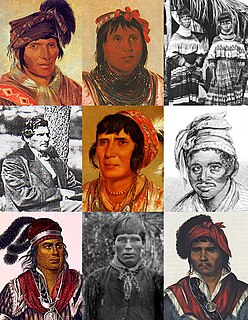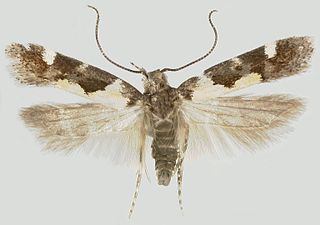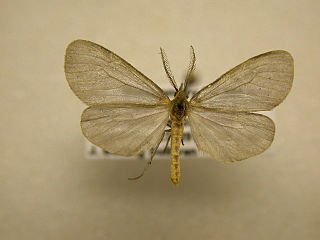
Indigenous peoples of the Southeastern Woodlands, Southeastern cultures, or Southeast Indians are an ethnographic classification for Native Americans who have traditionally inhabited the area now part of the Southeastern United States and the northeastern border of Mexico, that share common cultural traits. This classification is a part of the Eastern Woodlands. The concept of a southeastern cultural region was developed by anthropologists, beginning with Otis Mason and Frank Boas in 1887. The boundaries of the region are defined more by shared cultural traits than by geographic distinctions. Because the cultures gradually instead of abruptly shift into Plains, Prairie, or Northeastern Woodlands cultures, scholars do not always agree on the exact limits of the Southeastern Woodland culture region. Shawnee, Powhatan, Waco, Tawakoni, Tonkawa, Karankawa, Quapaw, and Mosopelea are usually seen as marginally southeastern and their traditional lands represent the borders of the cultural region.

Stegasta is a genus of moths in the family Gelechiidae.

Alpha Pi Omega Sorority, Inc. (ΑΠΩ) is the oldest historically American Indian sorority. It is also the largest Native American Greek letter organization, with 23 chartered chapters across nine states and the District of Columbia.

Pagara is a monotypic moth genus in the family Erebidae. Its only species, Pagara simplex, the mouse-colored lichen moth, is found in North America, where it has been recorded from Alabama, Arkansas, Florida, Georgia, Illinois, Indiana, Iowa, Kansas, Kentucky, Maryland, Mississippi, New Hampshire, North Carolina, Ohio, Oklahoma, South Carolina and Tennessee. Both the genus and species were described by Francis Walker in 1856.

Stegasta variana is a species of moth of the family Gelechiidae. It is found in Queensland, China, India, Malaysia, Réunion and Africa.

Schinia nubila, the camphorweed flower moth or brown flower moth, is a moth of the family Noctuidae. The species was first described by Herman Strecker in 1876. It is found from the US states of Oklahoma to New Jersey, south to Florida and Texas. Its range is expanding in the northeast. Furthermore, recorded from Colorado, Kansas, Oklahoma, Arkansas, North Carolina, South Carolina and Maryland.

The black-marked inga moth is a species of moth of the family Oecophoridae. It has been recorded from Costa Rica, Mexico, Arkansas, Oklahoma, Missouri, Texas, South Carolina, Alabama, Florida, Georgia, North Carolina and Virginia.
Hypsopygia binodulalis, the pink-fringed dolichomia moth, is a species of snout moth in the genus Hypsopygia. It was described by Philipp Christoph Zeller in 1872 and is found in the US from Texas to Florida, as well as in Georgia, Maryland, New Mexico, North Carolina, Oklahoma, Pennsylvania, South Carolina, Tennessee and West Virginia.

Ptichodis herbarum, the common ptichodis moth, is a moth in the family Erebidae. It is found in the United States. It has also been recorded from Jamaica.
Adela caeruleella, the southern longhorn moth, is a moth of the family Adelidae or fairy longhorn moths. It was described by Francis Walker in 1863. It is found in North America, including Alabama, Arkansas, Florida, Illinois, Kentucky, Louisiana, Maryland, Mississippi, North Carolina, Ohio, Oklahoma, Pennsylvania, South Carolina, Tennessee, Texas, Virginia and West Virginia.
Crambidia uniformis, the uniform lichen moth, is a moth of the family Erebidae. It was described by Harrison Gray Dyar Jr. in 1898. It is found from eastern North America, including Alabama, Florida, Georgia, Indiana, Iowa, Kentucky, Maryland, North Carolina, Ohio, Oklahoma, South Carolina, Tennessee and West Virginia.

Arogalea cristifasciella, the stripe-backed moth, is a moth of the family Gelechiidae. It is found in North America, where it has been recorded from Alabama, Arkansas, Connecticut, Florida, Georgia, Illinois, Indiana, Kansas, Kentucky, Louisiana, Maine, Maryland, Massachusetts, Michigan, Mississippi, Missouri, New Hampshire, New Jersey, New York, North Carolina, Ohio, Oklahoma, Ontario, Quebec, South Carolina, Tennessee, Texas, Virginia, West Virginia and Wisconsin.
Diathrausta reconditalis, the recondite webworm moth, is a moth in the family Crambidae. It was described by Francis Walker in 1859. It is found in North America, where it has been recorded from Alabama, Arizona, Florida, Indiana, Kentucky, Maryland, Massachusetts, Mississippi, New Hampshire, New York, North Carolina, Ohio, Oklahoma, Ontario, South Carolina, Tennessee and West Virginia.

Dichorda iridaria, the showy emerald moth, is a moth of the family Geometridae. The species was first described by Achille Guenée in 1857. It is found in North America, where it has been recorded from Alabama, Arkansas, Florida, Georgia, Illinois, Indiana, Iowa, Kentucky, Maryland, Massachusetts, Mississippi, New Hampshire, New Jersey, New York, North Carolina, Ohio, Oklahoma, Ontario, Pennsylvania, Quebec, South Carolina, Tennessee, Texas, Virginia, West Virginia and Wisconsin.

Polygrammodes flavidalis, the ironweed root moth, is a moth in the family Crambidae. It is found in North America, where it has been recorded from Alabama, Florida, Georgia, Illinois, Indiana, Iowa, Kansas, Kentucky, Maryland, Mississippi, Missouri, New Jersey, North Carolina, Ohio, Oklahoma, Pennsylvania, South Carolina, Tennessee, Texas, Virginia, West Virginia and Wisconsin.
Palpita kimballi, Kimball's palpita moth, is a moth in the family Crambidae. It was described by Munroe in 1959. It is found in North America, where it has been recorded from Alabama, Florida, Georgia, Louisiana, North Carolina, Oklahoma, South Carolina, Tennessee and Virginia.
Palpita illibalis, the inkblot palpita moth, is a moth in the family Crambidae. It was described by Jacob Hübner in 1818. It is found in North America, where it has been recorded from Alabama, Florida, Georgia, Maryland, Mississippi, North Carolina, Ohio, Oklahoma, Pennsylvania, South Carolina, Tennessee, Virginia and West Virginia.

Aroga compositella, the six-spotted aroga moth, is a moth of the family Gelechiidae. It is found in the United States, where it has been recorded from Alabama, Colorado, Florida, Georgia, Louisiana, Maine, Massachusetts, Mississippi, New Hampshire, North Carolina, Oklahoma, South Carolina, Tennessee, Texas and Wisconsin.
Stegasta abdita is a moth of the family Gelechiidae. It was described by Kyu-Tek Park and Mikhail Mikhailovich Omelko in 1994. It is found in Primorsky Krai in the Russian Far East and Japan.
Stegasta sattleri is a moth of the family Gelechiidae. It was described by Oleksiy V. Bidzilya and Wolfram Mey in 2011. It is found in the Democratic Republic of the Congo (Orientale), Ethiopia, Madagascar, Namibia, Tanzania and Zambia.














